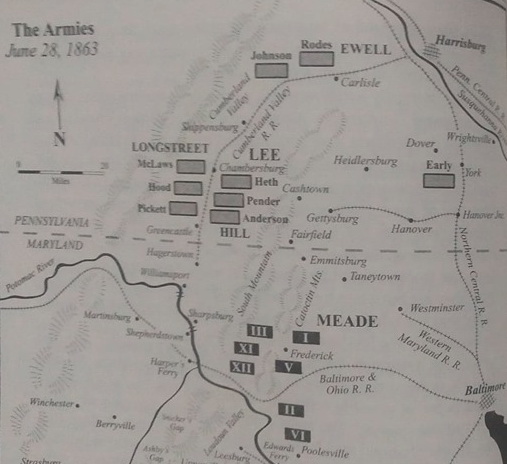Section 1b above contains a discussion of GEN Lee’s overall objectives of this campaign. Here I will concentrate on his expectations for 1 July 1863.

By the evening of 30 June, Lee’s grand scheme of this campaign was beginning to crumble. His plan to take the capitol city had been thwarted by the news that the Union Army was much closer at hand than Lee had thought possible. Ewell had also hesitated to capture the supplies at Carlisle. Lee had already dispatched an order to recall him to converge on the main force at Gettysburg on 1 July.
For Ewell, having received this order late in the day, it meant a early morning departure for the day-long march southward. But the order was for his entire corps to fall back to Gettysburg. This meant that he had to dispatch riders to locate MG Early’s division and have them reverse their march as well. All of this would take time. Ewell decided that rather than overload the direct route south to Gettysburg, he would send Johnson’s division on a parallel route taking him first to Cashtown. Ewell would follow Rodes on the road straight to Gettysburg. He expected to arrive in the early afternoon.
When Lee bedded down for the night in a small farm house just east of Cashtown, he was just behind LTG A.P. Hill’s Corps. Farthest to the east was MG Heth’s division. Lee had ordered Hill to have Heth make the short march to Gettysburg in the morning and to find the terminus of the Baltimore Pike. Heth was to establish a blocking position and await the rest of the army to converge.
Upon hearing those orders, Heth’s men were looking forward to a short walk and spending the day in the taverns and brothels of that fair city.
Marching immediately behind Heth were Pender’s then Anderson’s divisions. By afternoon, they would have fallen in on Heth and moved down the Pike to bivouac. It was to be a short day for all concerned. Lee could expect Ewell’s men to begin to arrive in the early afternoon. He’d have them move down the west edge of the city and encamp along the Emmittsburg Road, just south and west of the city. 2 July would be a day of rest while they waited for Longstreet to arrive. MG Pickett was the rear guard and he was expected by late afternoon of the second. Longstreet would bivouac his men just south of Cashtown along a small road that also led to Emmittsburg via Fairfield.
With Harrisburg off the table, Lee’s main concern at the moment was the location of the Army of the Potomac. He had no idea where exactly they were except that they were south and close! The best avenue of approach to Gettysburg was the BALTO PIKE, therefore, that was the point he wanted blocked first. Stuart’s cavalry should have been waiting at Gettysburg and would have been scouting south to find Meade who by now had to be in the general vicinity of Westminster. Since Emmittsburg was the next largest city in the area, that too would be a logical place for Meade to send troops.
With an attack on Harrisburg out of question, Lee had no actual plan except to find Meade and defeat him where ever he was.
Meade was of much the same mind as Lee. He had only a vague idea of where the Army of Northern Virginia was: somewhere north and east of the tip of South Mountain, but exactly where he, too, was blind.
On his order, LTG Reynolds had dispatched BG Buford’s cavalry division to locate the vanguard of Lee’s army. In this era cavalry had three main functions. They scouted ahead to locate the enemy. When they weren’t doing this, they were riding on the flanks of infantry in a protective mode known as screening. This function was particularly important to protect the vast wagon trains as well as the infantry formations while they were in the move. A lesser role was to conduct lightening raids on the enemy in support of the attacking infantry. At Gettysburg, this third function was never actually employed. On the morning of 30 June, Buford led his 3300 cavalrymen north towards Gettysburg with the intention of finding Lee’s army. For that day that was his mandate. He would do so much more!
Also see Section 30k A Pickett Relook.
